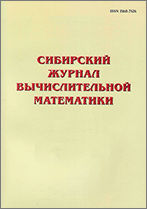|
|
Sibirskii Zhurnal Vychislitel'noi Matematiki, 2007, Volume 10, Number 4, Pages 401–416
(Mi sjvm96)
|
 |
|
 |
This article is cited in 2 scientific papers (total in 2 papers)
Mathematical modeling of formation of doping nanostructures in basic material (nanotechnologies for microelectronics)
G. A. Tarnavskiia, A. V. Alieva, A. G. Tarnavskiib
a Institute of Computational Mathematics and Mathematical Geophysics (Computing Center), Siberian Branch of the Russian Academy of Sciences
b Novosibirsk State University
Abstract:
Physical-chemical processes, which constitute the basis of one of segments of a technological cycle for designing new semiconductor materials for nanoelectronics, were numerically simulated. This production stage – the burning of basic material (Si, Ti or Ge) in oxygen – is intended for the formation of special nanostructures of donor (P, As or Sb) and acceptor (B, Ga or Al) dopings regularly distributed in the basic material before starting the burning. In this paper, investigation of the growth of dynamics of an oxide film and the study of redistribution of dopings by physical-chemical processes of segregation on “oxide/material” wave front is carried out for some version of employed configurations of the base surface (“trench”) partly closed by protecting masks, which preserve some segments of the surface from oxidation. The distributions of doping concentration, with generation of different domains, including specific nanostructures – short-located zones (60–80 nm) of elevated concentrations of the donor and the acceptor dopings, are obtained and analyzed. These nanostructures of the donor and the acceptor dopings in the base provide the required semiconductor electrophysical properties of material.
Key words:
nanotechnologies, design of new materials, mathematical modeling, oxidation of crystal silicon, doping segregation.
Received: 10.04.2007
Citation:
G. A. Tarnavskii, A. V. Aliev, A. G. Tarnavskii, “Mathematical modeling of formation of doping nanostructures in basic material (nanotechnologies for microelectronics)”, Sib. Zh. Vychisl. Mat., 10:4 (2007), 401–416
Linking options:
https://www.mathnet.ru/eng/sjvm96 https://www.mathnet.ru/eng/sjvm/v10/i4/p401
|

| Statistics & downloads: |
| Abstract page: | 621 | | Full-text PDF : | 228 | | References: | 53 |
|




 Contact us:
Contact us: Terms of Use
Terms of Use
 Registration to the website
Registration to the website Logotypes
Logotypes








 Citation in format
Citation in format 
